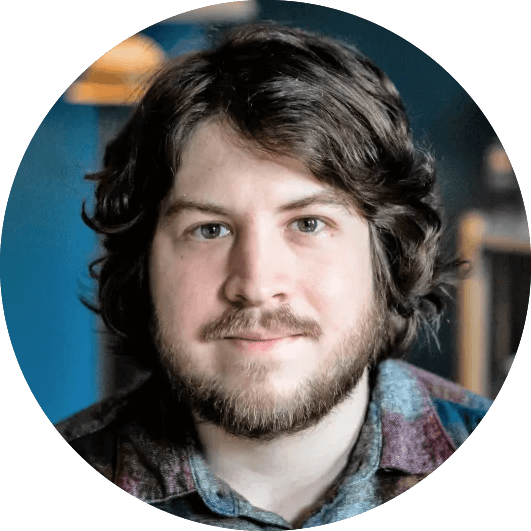Explore how the sound was created for "Weird Al" Yankovic's biopic parody with sound artists Anthony Vanchure & Mike James Gallagher.
Weird: The Al Yankovic Story is the true story of parody musician "Weird Al" Yankovic – or so he’d have you believe for 108 minutes. Masterfully crafted to send up the self-indulgence of modern musical biopics, the film (which stars Daniel Radcliffe) simultaneously ridicules and pays homage to the genre while spicing it up with a splash of Hollywood-style action. Taking the viewer on a wild ride from Al’s humble beginnings to the heights of stardom and the depths of despair, along with a stop at Pablo Escobar’s birthday party, the film is full of humor, drama, thrills, and – of course – Weird Al’s music.
We spoke with Supervising Sound Editor Anthony Vanchure and his frequent collaborator, Sound Designer Mike James Gallagher, to get the inside scoop on how the surprisingly detailed sound of this unorthodox movie came to be.
What kind of direction did you receive when starting this project, and how did your approach to the sound of this film take shape?
Anthony Vanchure (AV): I met with the director, Eric Appel, and the editor, Jamie Kennedy; and they discussed what they were looking for and what their ideas were for sound. I had some ideas after reading the script, and then during the spotting session everybody got a chance to throw out ideas. It was very freeform – just kind of like, “Let's try this,” or “Let’s try that.”
Mike James Gallagher (MJG): My first thought was, “We’ve gotta throw some Three Stooges- or Loony Tunes-type stuff in there.” But then, as we started working on the movie, we realized how serious it plays a lot of the time.
AV: It was very much like, “Let's play this straight for the whole movie, let's cut as if this were a real biopic. We're gonna pretend this isn't a parody and everything's gonna be played straight.”
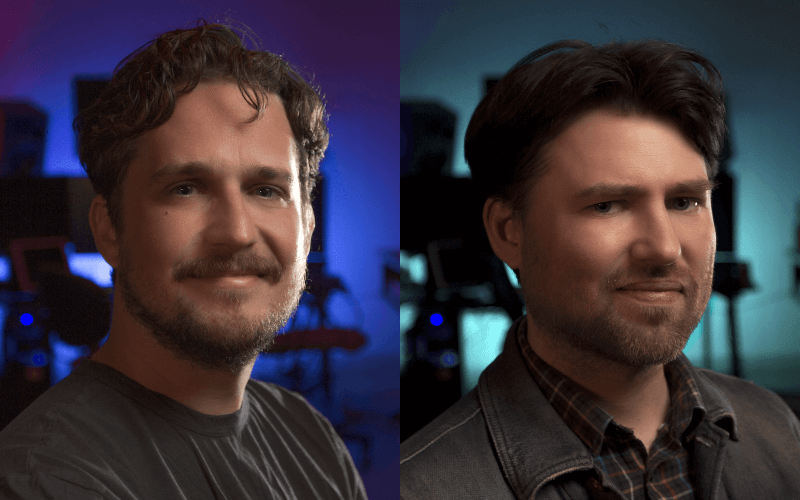
Anthony Vanchure (left), Mike James Gallagher (right)
That commitment to the bit is definitely what makes it work, but you still got a chance to do some elaborate sound design. For example, early in the film, an accordion gets smashed in a very dramatic way and we hear wood splintering in slow motion while pieces of debris whiz past the camera. What went into that sound?
MJG: That was all abstract, slow-motion sound effects. It's funny, because I kind of buried the little wood ricochet thing that happens, but our mixer, Tony Solis, went through every single layer and found that sound, lifted it up in the mix, and flew it past us. I was really happy about that. I thought my effects sounded pretty good, but once they got to Tony, he really made them sing. We joked about it being mixed in Atmos because it was a Weird Al movie, but then we realized how cinematic it is, and we took advantage of Atmos a lot. Tony was always dragging my effects down to the object tracks and flying them around.
The environments are also very detailed. When Al decides to record his first parody song, he and his friends set up in a bus station bathroom for its “great” acoustical properties. Anyone who’s into sound knows what a challenge that can be – how did you establish that echoey reverb without the mix becoming a blurry mess?
AV: There was a bit of back and forth on that scene because initially we had it really drowned out in reverb to make it sound like a public bathroom, but then we all realized it was more important to hear the song.
MJG: I established the ambience of that room with a big sound effect of him opening the door, and there was echo built into a lot of the effects that I cut in. But after that moment, I eased up on the reverb because you've already heard that sound, so you can slowly come back into the scene.
AV: There was another sound I wanted to add in that scene, I won't say what, but it got shut down very quickly. Since it’s a bathroom scene, you can probably guess.
“When Mike and I are cutting, my note always is just, ‘Go as big as we can.’ I'd rather have more stuff to work with on the mix stage and if we have to come down a little, that’s okay.”
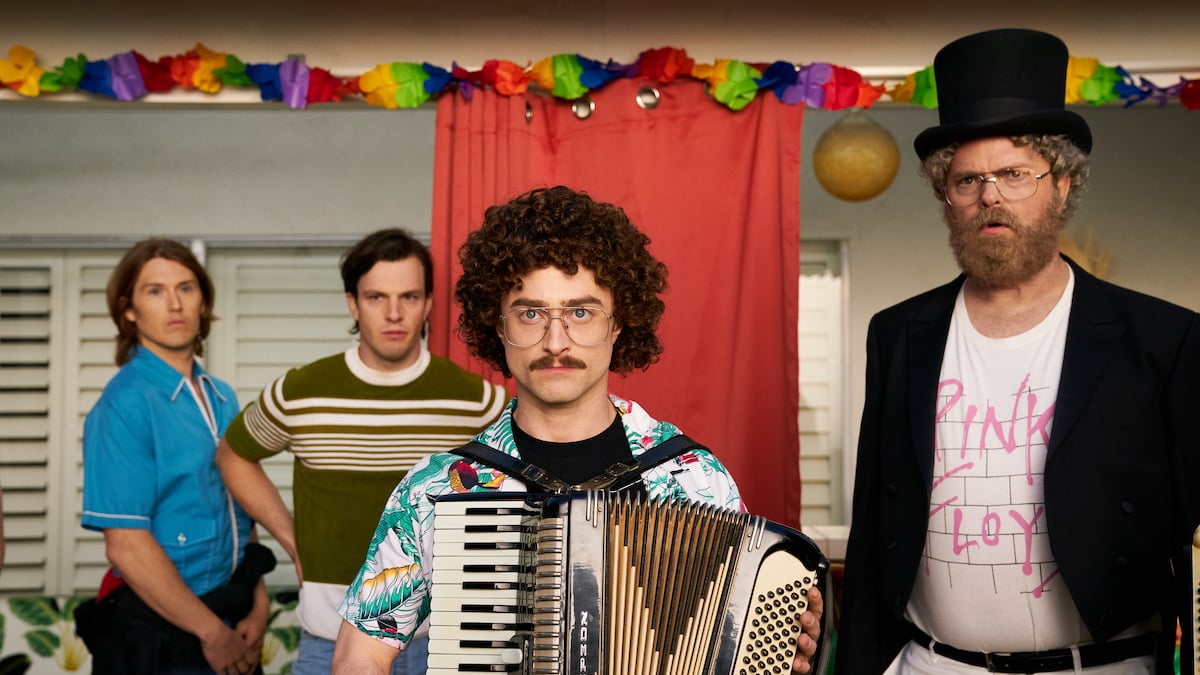
Sound can create such a visceral reaction when used well. For instance, the first time Al gets onstage, there’s some hilariously drawn-out microphone handling and feedback that really makes you cringe. We’ve all heard that audio trope, but you really took it to the next level.
AV: The note from our director was that it's his first time performing in front of an audience and it’s at sort of a biker bar, so you really want to enrage these people. The note was like, “Let's make this extra long and excruciating so that the audience really hates Al.”
MJG: That was a lot of Odyssey Complete, but also I used the King Collection for the mic stand movement. I don't know what I would do without those libraries. I don't mind recording things like that, but when you're in a hurry, you have to have a robust library to pull from.
The crowds in the performance scenes are very full and surprisingly detailed. Did you achieve this using sound libraries, loop group, or both?
MJG: It was a mix of both. For the big, blurred sound we used a lot of stuff from Odyssey Complete. But when you need more focus, you can't really get that with sound effects libraries, so you have to do it with loop group.
AV: When we were talking about crowds, Eric wanted to try to get them to be like the crowds in A Star is Born with Lady Gaga and Bradley Cooper. That was something that we worked with our Loop group on to make sure we were getting our crowds just right. We spent a whole day with them going through all those scenes and just getting little things perfect. Then, blending that stuff with sound effects really helped make those crowd scenes sing.
This brings us to a funny story – there's a scene where Al's on stage, he's drunk, he's got his shirt off, and he’s yelling at everybody. There was a particular moment where the crowd's supposed to be chanting back “No!” but in an excited way. So we had our loop group do that, but during the mix, Al said it wasn’t quite sounding like a big, raucous arena. Al was on tour the whole time we were mixing the movie, so we're on the mix stage – pretty late into the mix – and I was just like, “Al, do you think you could record your audience tonight?” We didn’t actually want to bother Al with that, but he got so excited and wouldn’t let it go. So that night he went on stage, and about three hours later I had a 96 kHz stereo recording sent to me!
“We spent a whole day with [our loop group] going through all those scenes and just getting little things perfect. Then, blending that stuff with sound effects really helped make those crowd scenes sing.”
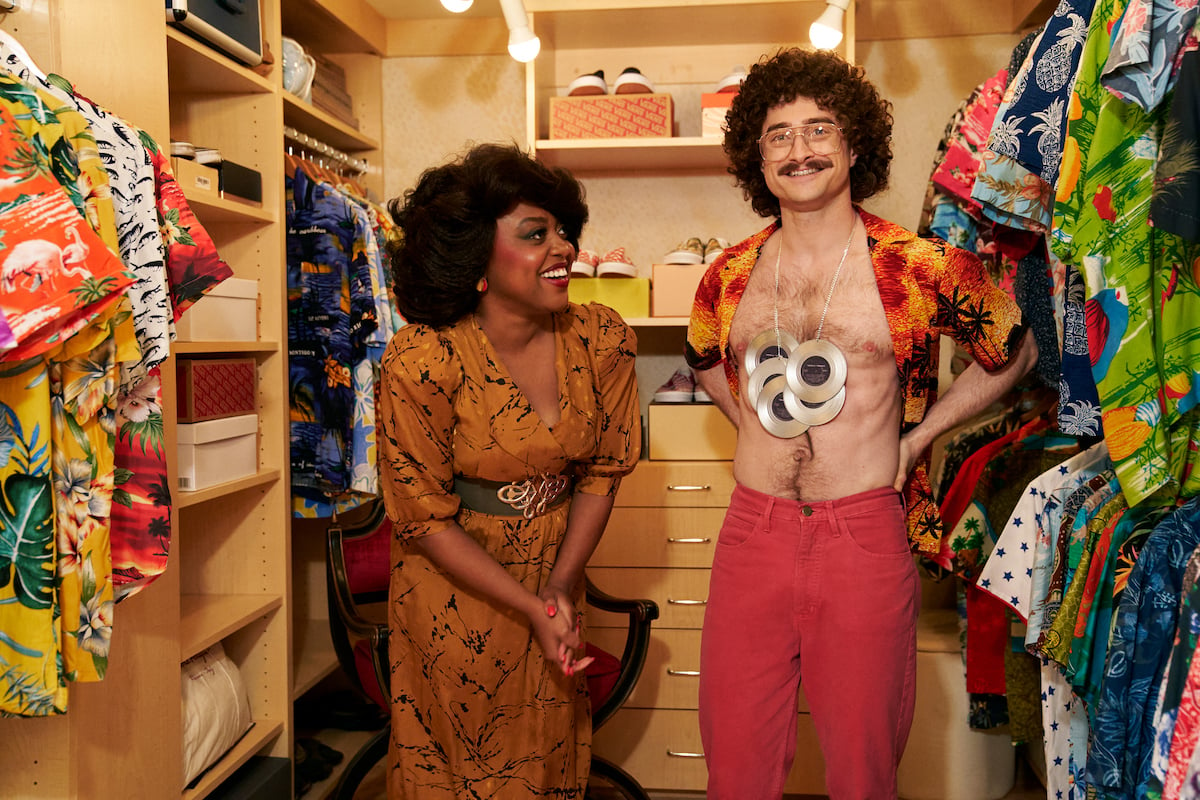
The music in the film is excellent as well. One of the best moments takes place at a pool party full of famous weirdos from history where Al performs “Another Rides the Bus” on accordion while his band plays a variety of novelty instruments. It’s such a silly scene, but it’s very tense at the same time, and the mix is fantastic. How did that scene come together?
AV: Al re-recorded all of his songs specifically for this movie so that we could have all the stems, because for a lot of his older songs, they just don't have the multitracks anymore. And for that scene in particular, he wanted a bunch of these sounds of the Flexitone that Andy Warhol [Conan O’Brien] plays in that scene.
MJG: Eric bought one off Amazon while we were in the mix. It was funny because I went to try playing it and I was like, “This kind of sounds like crap,” but Eric had spent the entire weekend learning how to do it and it sounded amazing.
AV: The “hand farts” throughout that scene were done by “Musical Mike” Kieffer. Al had worked with him in the ‘80s, and got him to come in and record hand farts for the movie. We did a whole two-hour session with multiple mics so we had a nice stereo image, and it was just this beautiful symphony of hand farts.
The action sequences go surprisingly hard, and it’s the sound that really gives it that overblown Hollywood style. What are your go-to sources for those huge-sounding punches, gunshots and the like?
MJG: Because it's a parody, anything goes, so I just did everything. There's a lot of Matrix-style whooshes, for example. One of my favorite sounds is from the King Collection library, and the file is just called “Beefy Punch” or something like that. It’s all in stereo and I use it all the time, especially when the bigger guys are attacking him. Those specific hits are really, really beefy. You just go as big and crazy as possible. The guns are 100% King Collection: Guns. My reference for those was Michael Mann movies, specifically Heat. I just love how insanely huge Michael Mann's gunshots are. And again, for a parody movie like this, you just go hard.
AV: You want it to sound big and massive, and when Mike and I are cutting, my note always is just, “Go as big as we can.” I'd rather have more stuff to work with on the mix stage and if we have to come down a little, that’s okay. But sometimes you get lucky and the directors go, “That sounds perfect the way it is,” and we get to leave those guns sounding huge.
MJG: In one of the fights, Al whips someone with a towel, and I really wanted that towel whip to sound like a sonic boom ripping through the air. And in the surround sound mix, it rips past you. I think I used a recording of a bullet whizzing by, and I can almost guarantee that in that towel whip sound are these King Collection energy sounds.
Like any great movie, there’s a trippy LSD-fueled dream sequence full of terrifying imagery. There’s raging hellfire, a factory machine that eats people, a dark forest with thunder and lightning, and a climax where Al hatches from a giant egg with an electric guitar. This kind of scene is a sound designer’s dream, but did it also present a challenge for you?
MJG: The biggest thing with that sequence is you don't want it to turn into a fiery white noise mess. In the VFX there are these little spurts of fire shooting off throughout the scene, so I was able to highlight that without just flaming everything. That's actually a big Atmos sequence with the fire going into the ceiling. There's also a lot of vocal effects too, because his parents are demons in that sequence.
AV: It's got such a wide variety of things going on. There’s the music, all the effects and the dialogue stuff. The more you have in a scene, the more you notice little things that are missing. And so you're always just like, “Well we have this big sound for this, but now this one little fire effect is missing.” It was definitely a process to make sure we could get everything sticking so we can hear those effects when we want to, and let the music ride when we want to hear that.
MJG: When I was making the sound of that factory machine, I actually started with the second time it appears, near the ending. I remember Anthony calling me in the middle of doing it, and I was like, “Man, I don't know if I'm gonna get this in time.” I was packing a lot of factory and machinery sounds into it, but it was just turning into mush, so I put that on the back burner and then I did the LSD sequence next. And when I was designing that, I was thinking of it more from a dream perspective, and that helped me crack the sound. Suddenly it was much more simple. I recorded a sound effect of me running a spoon across a serrated knife, then added some mechanical screams and some really low lava rumble. It's really just those three elements and they work together really well. Then I just took those sounds from the LSD trip and put them at the end and it worked perfectly. I just had to stop thinking from a realistic perspective and just make it interesting and cinematic and big, and that helped me crack it.
“What saves me on everything is Odyssey Complete from Mark Mangini and Richard L. Anderson. When you only have a few weeks to cut a movie, you gotta lean on that.”
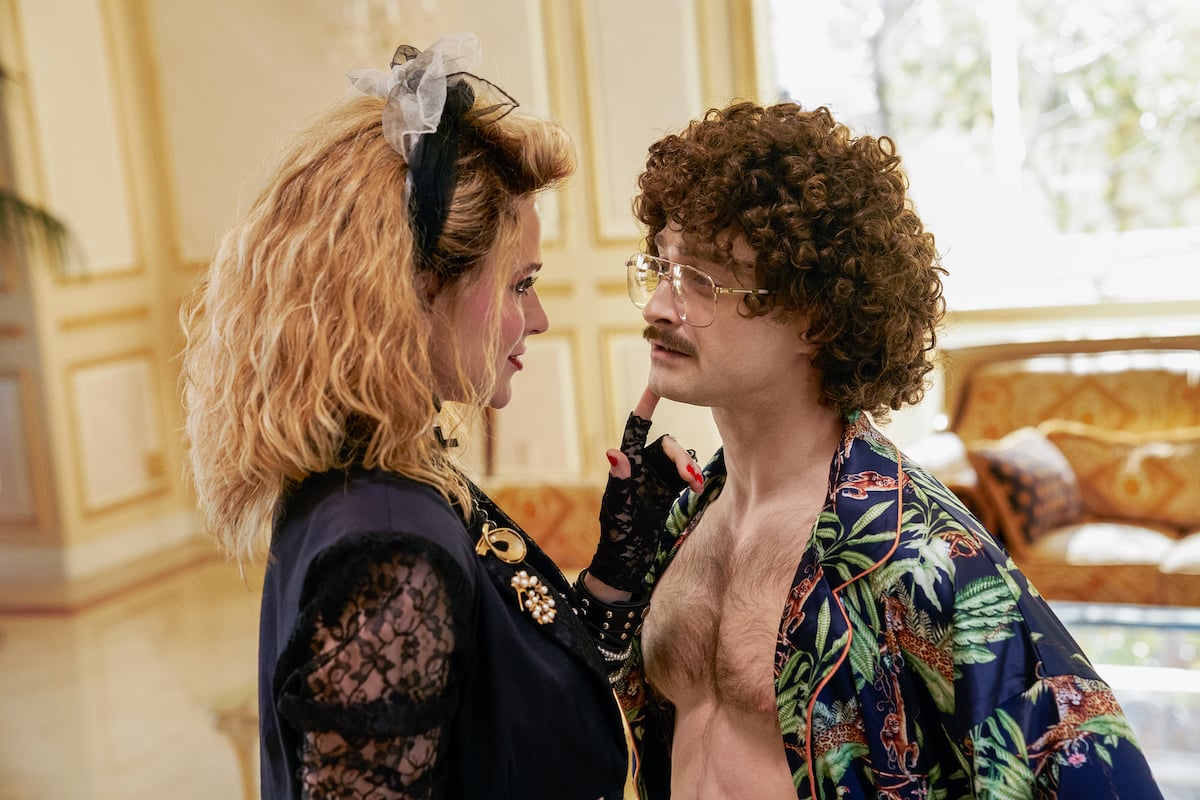
You were under a pretty tight deadline for this project but you still managed to pack a lot of detail into the sound effects. It sounds like having comprehensive general libraries helped you find what you needed fast and keep moving. Any in particular you want to give a shout-out to?
MJG: What saves me on everything is Odyssey Complete from Mark Mangini and Richard L. Anderson. When you only have a few weeks to cut a movie, you gotta lean on that.
AV: I think both of us agree that that thing has saved us so many times. You gotta use what you know is gonna work.
MJG: We were working on this show called Song Exploder for Netflix, and in the episode about the Nine Inch Nails song “Hurt,” there's this quick scene where Trent Reznor’s trashing a drum set. I’ll always remember thinking, “There's no way I'm gonna find a drum set being trashed.” But I searched for it in Odyssey Complete and there’s actually a recording of someone knocking over a drum set and throwing cymbals on the ground. I was just like, “Of course. I should never doubt Odyssey again.”
Bonus Interview:
This film all started as a satirical trailer produced by director Eric Appel for Funny Or Die in 2010. Cut to 2022, and we have a full-length feature released on The Roku Channel, produced by Funny Or Die and Tango Entertainment.
Funny Or Die happens to be a long-time client of Pro Sound Effects, so we caught up with their Senior Director of Post Production, Phillip Loeb, to learn about his team's experience working with the PSE library to bring stories to life. Here's what he had to say:
"Pro Sound Effects has long been a great tool for the post teams working with Funny Or Die. Sound effects, especially in comedy, are really key to the punctuation of a joke and can be the difference in making a moment go from polite chuckle to auditorium filling laughter. You really can't overstate how important the sound effects are to grounding you to a sense of place and enhancing the tone of a piece. To that end, Pro Sound Effects has been great because of the diversity of elements they provide in their libraries. This has enabled the creative teams to explore their audio world with any elements they desire in everything from short form videos for social media and all the way to big scale productions like Weird."
– Phillip Loeb
Senior Director of Post Production
Funny Or Die


